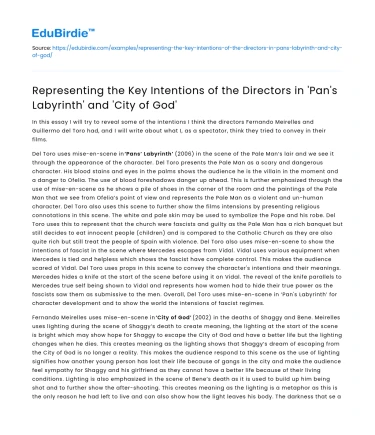In this essay I will try to reveal some of the intentions I think the directors Fernando Meirelles and Guillermo del Toro had, and I will write about what I, as a spectator, think they tried to convey in their films.
Del Toro uses mise-en-scene in ‘Pans’ Labyrinth’ (2006) in the scene of the Pale Man’s lair and we see it through the appearance of the character. Del Toro presents the Pale Man as a scary and dangerous character. His blood stains and eyes in the palms shows the audience he is the villain in the moment and a danger to Ofelia. The use of blood foreshadows danger up ahead. This is further emphasized through the use of mise-en-scene as he shows a pile of shoes in the corner of the room and the paintings of the Pale Man that we see from Ofelia’s point of view and represents the Pale Man as a violent and un-human character. Del Toro also uses this scene to further show the films intensions by presenting religious connotations in this scene. The white and pale skin may be used to symbolize the Pope and his robe. Del Toro uses this to represent that the church were fascists and guilty as the Pale Man has a rich banquet but still decides to eat innocent people (children) and is compared to the Catholic Church as they are also quite rich but still treat the people of Spain with violence. Del Toro also uses mise-en-scene to show the intentions of fascist in the scene where Mercedes escapes from Vidal. Vidal uses various equipment when Mercedes is tied and helpless which shows the fascist have complete control. This makes the audience scared of Vidal. Del Toro uses props in this scene to convey the character's intentions and their meanings. Mercedes hides a knife at the start of the scene before using it on Vidal. The reveal of the knife parallels to Mercedes true self being shown to Vidal and represents how women had to hide their true power as the fascists saw them as submissive to the men. Overall, Del Toro uses mise-en-scene in ‘Pan's Labyrinth’ for character development and to show the world the intensions of fascist regimes.
Save your time!
We can take care of your essay
- Proper editing and formatting
- Free revision, title page, and bibliography
- Flexible prices and money-back guarantee
Fernando Meirelles uses mise-en-scene in ‘City of God’ (2002) in the deaths of Shaggy and Bene. Meirelles uses lighting during the scene of Shaggy’s death to create meaning, the lighting at the start of the scene is bright which may show hope for Shaggy to escape the City of God and have a better life but the lighting changes when he dies. This creates meaning as the lighting shows that Shaggy’s dream of escaping from the City of God is no longer a reality. This makes the audience respond to this scene as the use of lighting signifies how another young person has lost their life because of gangs in the city and make the audience feel sympathy for Shaggy and his girlfriend as they cannot have a better life because of their living conditions. Lighting is also emphasized in the scene of Bene’s death as it is used to build up him being shot and to further show the after-shooting. This creates meaning as the lighting is a metaphor as this is the only reason he had left to live and can also show how the light leaves his body. The darkness that se after foreshadows the pain and the chaos that will happen in the city, this builds up tension and for the audience and are on the edge of their seat to see what happens next. The impact of deaths is also shown through the reactions of Shaggy’s girlfriend. The close-up of Shaggy's girlfriend presents facial expressions of sadness which makes the audience feel sympathetic for her because of her heartbreak and Angelica (Bene's girlfriend) is presented at a high angle after his death which shows her loss at her boyfriend's death and her fear of Lil Ze. Consequently, Meirelles uses cinematography throughout ‘City of God’ to capture the character reactions at pivotal moments and to create a response for the audience.
Overall, ‘Pans’ Labyrinth’ and ‘City of God’ both represent loss, pain and violence which make the audience feel sympathy, but also are made to feel closer to the character as they understand what they’re going through.
Did you like this example?
Make sure you submit a unique essay
Our writers will provide you with an essay sample written from scratch: any topic, any deadline, any instructions.
Cite this paper
-
APA
-
MLA
-
Harvard
-
Vancouver
Key Intentions of Directors in ‘Pan’s Labyrinth’ and ‘City of God’.
(2023, March 01). Edubirdie. Retrieved December 22, 2024, from https://edubirdie.com/examples/representing-the-key-intentions-of-the-directors-in-pans-labyrinth-and-city-of-god/
“Key Intentions of Directors in ‘Pan’s Labyrinth’ and ‘City of God’.” Edubirdie, 01 Mar. 2023, edubirdie.com/examples/representing-the-key-intentions-of-the-directors-in-pans-labyrinth-and-city-of-god/
Key Intentions of Directors in ‘Pan’s Labyrinth’ and ‘City of God’. [online].
Available at: <https://edubirdie.com/examples/representing-the-key-intentions-of-the-directors-in-pans-labyrinth-and-city-of-god/> [Accessed 22 Dec. 2024].
Key Intentions of Directors in ‘Pan’s Labyrinth’ and ‘City of God’ [Internet]. Edubirdie.
2023 Mar 01 [cited 2024 Dec 22].
Available from: https://edubirdie.com/examples/representing-the-key-intentions-of-the-directors-in-pans-labyrinth-and-city-of-god/
copy






 Stuck on your essay?
Stuck on your essay?

